The obvious often isn’t until someone makes it so.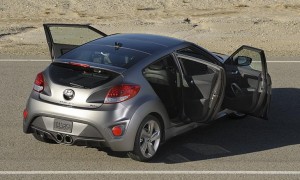
For instance, adding a real-sized rear door to a sporty coupe – as Hyundai has done with the Veloster.
Much better than one (or even two) quarter-sized rear doors, as in cars like the old Saturn Ion – and more recently, the Mazda RX8.
It’s as easy to get in and out of the Veloster’s back seat area as it is to get in and out of the front seats – and from the driver’s side, the Veloster still has the clean lines of a two-door coupe. Best of both worlds in the same package.
And now, a twin-scroll turbo and 201 hp has been added to the mix.
The Veloster is a clever merger of the functional – and the fun. It can be compared with other sporty, snarky-looking compact-sized FWD hatchbacks like the Mini Cooper, Scion tC and Fiat 500 – but touts the additional everyday advantages of a passenger-viable (and passenger-accessible) back seat.
Prices start at $17,600 – which is about $2k less than the base Mini Cooper ($19,700), and about $1,100 less than a base Scion tC – and $1,600 more than the base model Fiat 500 ($16,000).
The mid-trim RE:MIX starts at $20,050.
The new turbo Veloster starts at $22,100 – about the same as a Honda Civic Si ($22,515) and about $2k more than a Fiat 500 Abarth ($19,500).
Both the “factory custom” RE: MIX trim and the turbo Veloster are new for 2013. The turbocharged engine gives the Veloster the guts it needs to be seen as a legit performance car – as opposed to a merely sporty-looking car. The RE: MIX version, on the other hand, is Hyundai’s way of offering buyers a personalized Veloster – much in the same way that Mini (and Fiat) lets buyers trim out cars with dealer add-ons to make each one as unique to its owner as possible for a mass-produced car.
One bit of mixed-bag news is that the ’13 Veloster’s standard (non-turbo) engine is de-powered slightly for the new model year – down to 132 hp (vs. 138) if you go with the optional automatic over the standard six-speed manual transmission.
But, the upside is slightly improved gas mileage in city driving.
Fun, affordable – and fairly practical.
Turbo engine lops almost 2 seconds off the 0-60 time.
Excellent to-the-side visibility.
Looks like nothing else.
WHAT’S NOT SO GOOD
Even with the new turbo, 0-60 time is just so-so (mid sevens).
Limited view of what’s behind you.
Headroom is tight – in both rows.
Seats are not long-trip friendly.
The Veloster’s standard 1.6 liter engine produces 138 hp with the also-standard six-speed manual transmission – or 132 with the optional six-speed automated manual, or ECO-DCT (in Hyundai-speak). This is a manual transmission that doesn’t need any input from you – unless you want to. The computer handles the clutchwork – and also the gear changes, unless you decide you want to up and downshift for yourself. These automated manuals are as or more efficient than a human-controlled manual and as automatic as – well – an automatic transmission.
The manual version is quickest, getting to 60 in just over 9 seconds while the DCT auto-manual version takes about 1 second longer. This business of the automatic-equipped version lagging a step (or three) behind the manual version of the same car is also true of the Fiat 500 and Mini Cooper, by the way. The manual Cooper gets to 60 in about 8.4 seconds – but the same car with its optional automatic takes about 9.5. The base Fiat 500 gets to 60 in just over 10 seconds – but the same car with its optional automatic takes 12.4 seconds.
Automatic transmissions ( whether they’re automated manuals or conventional automatics) just don’t do their best work – from a performance point-of-view- when teamed up with small (and low torque output) engines such as the engines in these kinds of cars. They need to rev into the upper reaches of their powerbands to access their power curves – and with an automatic, it takes the engine a moment or three to get spinning – and get the car going.
Hence, The Slows.
So, what’s the upside to the automatic? In particular, for an automated manual such as the one that’s offered optionally in Veloster?
A slight uptick in MPGs is your reward for a lower ET.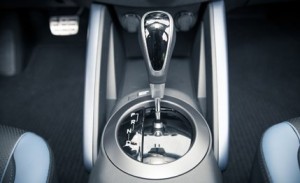
The DCT-equipped Veloster achieves an EPA rating of 28 city, 37 highway. The manual version comes in at 27 city, 37 highway. You’ll have to decide whether that 1 MPG gain is worth the loss of 1 second, zero to sixty.
Either way, the Hyundai’s mileage is right there with the Mini (29 city, 37 highway with the manual). The Fiat 500 is the pack leader with an excellent 31 city, 40 highway rating. However, that’s with the manual transmission. If you choose the automatic-equipped 500, mileage drops to 27/34 – worse than all the others in this segment. And why? The Fiat’s automatic is an ordinary automatic (hydraulic, with a torque converter) not a more efficient automated manual like the Veloster’s.
But the real headline for 2013 is the newly available turbocharged (twin scroll) version of the 1.6 engine. It makes 201 hp – making it stronger than the Mini Cooper S’s turbo engine (181 hp) and also the Fiat 500’s newly available turbo engine (135 hp). It also knocks about 2 full seconds off the base Veloster’s 0-60 time. Instead of mid nines, you’ll be running mid-low sevens. As is the case with the MPGs of the base Veloster relative to the competition, the 0-60 ET of the turbo Veloster falls solidly in between the Mini Cooper S – which is quicker (6.6-6.7 seconds) and the Fiat 500 turbo, which is slower (eights).
Now, both the Mini and the Fiat 500 offer a third option – a 208 hp turbo engine in the JCW version of the Cooper and a 160 hp turbo engine in the 500 Abarth. Either of these will outrun the Veloster, 0-60 (6.2 second for the Mini JCW; 7.1 seconds for the Abarth 500). However, their base prices – $30,100 for the JCW Mini and $26,000 for the Abarth 500 – make a direct comparison slightly unfair. And, Hyundai could – and hopefully, will – up the ante next year, by adjusting the output of the 1.6 engine. Or perhaps – we can dream – offering the Sonata’s optional 2.0 liter turbo engine in the Veloster. In the Sonata, the 2.0 turbo delivers 274 hp.
Imagine that kind of power in the Veloster …. .
Oh, and PS: The Slows are not an issue with the Veloster’s 1.6 turbo engine when teamed with the DCT automatic – because the turbocharger massively increases the low-end torque output of this engine: 195 lbs.-ft of torque at 1,500 (and maintained through 4,500 RPM) vs. 123 lbs.-ft that doesn’t arrive until 4,850 RPM. And, gas mileage remains good: 24 city, 31 highway – which is very close to the what the super cute – but super slow (12-seconds-to-60) automatic-equipped base (non-turbo) Fiat 500 manages.
Final item: The Veloster turbo engine is designed to run on regular 87 octane unleaded. Not can be run on regular unleaded (with reduced power/performance).
Designed to run on it.
Saves you – on average – about 20 cents per gallon.
I’ve driven both versions – base and turbo – and they are each equally fun to drive. The base car isn’t the quickest thing on wheels – but then, neither are its price-equivalent competitors. And, frankly, quickness isn’t everything. It has been said – and I agree with this – that it can be more fun to drive a slow car fast than a fast car slow. You work it – and it works you. The car’s limits are lower – so you get closer to yours (as a driver) sooner. In the base car, you focus more on the cornering as opposed to the stoplight to stoplight drag racing. That can be its own kind of fun. Ask any Miata owner.
On the other hand, the turbo’s merits are – obviously – the quicker acceleration and also (less obviously) that you can go with the automatic and not lose that quicker acceleration, courtesy of the abundant torque down low. There is also the pleasantness – to the enthusiast’s ear – of an audible turbo whistle as the 1.6 engine comes on the boost – which rises as high as 18 psi. I think it ought to be more audible. And also that Hyundai should provide a boost gauge so you can see the boost building as well as hear it. The current fad is to make turbo engines behave like – and sound like – large displacement non-turbo engines. To hide the fact that they are turbo’d. Hence, no gauge – and often, little or no turbo whistle. The boost is in the background. No sudden eruption of power as the turbo comes online; no left-the-right skittering of the overwhelmed front wheels as the torque washes over them. Instead, there’s the feel of a strong V-6 – without a turbo. That’s part of the nature of a twin-scroll turbo – which has not one but two exhaust gas inlets, in order to achieve more consistent/less peaky power delivery – and reduce (if not eliminate) the sudden surge of power people associate with a turbo engine on boost.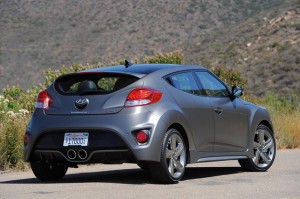
Depending on your preferences, this is a plus – or a minus. I like two-stroke motorcycles from the ’70s. So I like wild-child rides. I really like the Fiat 500 Abarth – which is a vicious little SOB that snaps and feels like it’s going to throttle wheelie on you like an H2 750 at full twist. The turbo Veloster – I think – could stand to be de-civilized a bit. A bit more boost, maybe. More obviously delivered. More whistle.
And a gauge – please.
But, these are subjectives – and I suspect most people (being more reasonable people) will be very happy with the mild manners of the Veloster turbo. It is without question more of an everyday-viable car than that magnificent – but hairy – 500 Abarth.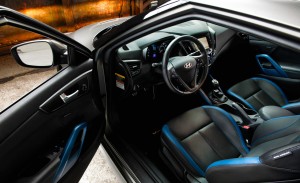
Handling-wise, the V-ster is also a distinctly different kind of car. The 500 is lots of fun, but its super-abbreviated wheelbase (90.6 inches) renders it a bit darty in crosswinds and at higher speeds. The Veloster’s much longer wheelbase (104.3 inches) gives it a stability and plantedness – as well as a smoothness – that both the 500 (and the Mini, with its 97.1 inch wheelbase) can’t match. It’s also not as stiffly-sprung – especially relative to the Mini S and 500 Abarth. However, I found the Veloster’s seats to be a little hard-on-the-rear. So did my wife, so it’s not just me. They were fine for say an hour or so. But we found that after about two hours in situ, our cheeks began to complain. Maybe yours won’t. Seat feel/comfort is a very subjective thing. But I do strongly recommend test-driving the car for at least an hour to see how the seats feel on your cheeks.
One thing I really like about the Veloster is the superb to-the-side visibility, something that is becoming increasingly uncommon as the average new car’s B pillars thicken to I-beams and side glass gets smaller and rooflines ever-lower. But thanks to the Veloster’s extra door (passenger side) there is also a lot more glass area thatn you’d get in a “true” (two-door) coupe – so you can see what the hell is coming at you from the right as you make ready to turn left into traffic from a sidestreet.
But, then there’s the view behind you. It’s a tunnel-view. You see some light at the end of it, but not much else. That slanting roofline – and micro-sized piece of backglass. It looks great. You just can’t see much of the outside from inside. This is an issue that afflicts more and more new cars – and it’s why more and more new cars either come standard with or offer back-up cameras.
Which, of course, the Veloster does, too.
From the driver’s side, the Veloster appears to be a two-door. To see the third door, you’ve gotta walk around to the other side – where the passengers will be glad to see it. It is – physically – about as large (and wide-opening) as the passenger side front door. This is much more serviceable than the mini-doors used in cars like the Mazda RX-8 and Saturn Ion. Getting in – and out – of the Veloster’s back seat area is pretty much exactly like getting into – and out of – the back seat area of a compact sedan.
Legroom is also good – 31.7 inches – or slightly more than than in the Mini (29.9) and exactly the same as the Fiat 500.
Headroom, though, is tight – and not just in the backseat. But, let’s start there. The Hyundai’s chopped roof leaves only 35.3 inches of rearseat headroom. The Mini’s got two inches-plus more head space (37.6) and even the much small (overall) Fiat 500 comes in at 35.6 inches. Luckily, the back seats are angled backward such that most people – adult people – can still sit back there without abusing themselves. At least, for short hops.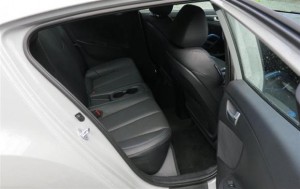
Up front, headroom’s better – 39 inches – which is actually slightly more headroom than both the Mini (38.8) and the 500 (38.9) however, the way the roofline curves (especially with the optional panorama glass sunroof) I found that the left side of my head brushed up against the headliner. If you’re less than 6ft 3 (like me) you’ll probably be ok – but as with the seats – you’ll want to put yourself inside to see how it fits you.
Cargo capacity with the second row not folded – 15.5 cubic feet – is among the best in class. the Fiat 500 has 9.5 cubic feet; the Mini just 5.7 cubes.
I think the car looks like a kind of sheetmetal horny toad – which is a compliment. It has reptilian ridges – and a (to me) very distinctly saurian squat. The best view, in my opinion, is the view from behind. The twin tailpipes (in the turbo model) smugged up together and centrally located look tough – the car’s squat accentuated by the punched out fender flares. From the side, too, the view is pleasantly original – and that includes the passenger side. The extra door’s presence is rendered discreet – almost invisible – by the absence of an obvious door pull. Look left – and up. That dummy rear quarter window? It’s the door pull.
Some reviewers have put the Veloster in the same category as the VW Beetle and (as far as the turbo Veloster) the Honda Civic Si. I don’t – because while those cars are also technically compact/sport-minded hatchbacks, they’re much more conventional in ‘tude. The Beetle is retro. The Civic Si is anonymous. The Mini Cooper and Fiat 500 are closer in ‘tude – but they’re also very different, each in their own way. Not necessarily worse – or better.
Just different.
The V-ster isn’t quite like any of them.
Odds n’ ends: There are a lot of small detail items that add to the hipness factor of the Veloster – for example, the available “throwing star” wheels. And the “floating” door pulls inside. Also the flush-mounted rear console. And the almost snake-skin textured dashpad.The way the center stack has been designed to mimic the shape of a sport bike’s gas tank.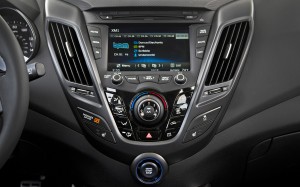
Very cool.
The turbo model is available with contrast blue seat bolsters – with matching contrast blue front console side bolsters. If you choose the RE: MIX, you get (in addition to the exterior body kit) unique-to-this-model 18-inch wheels, LED cabin lighting, tail-lights and running lights, an upgrade Dimension sound system and monogrammed floormats.
All trims – including the base $17k version – come with Hyundai’s Pandora Internet radio capability, BlueLink telematics – as well as AC, keyless ignition, power windows, locks , touchscreen interface and a very good six-speaker stereo with satellite radio and iPod interface.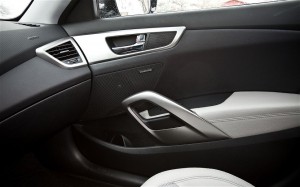
The roof-length panorama glass top (with moveable/opening front section) is the major big-ticket option, part of an Ultimate package ($2,500) that also includes a 115V accessory power point and GPS with back-up camera.
I like the pull-up parking brake – and that the traction control is easy to turn off by just pushing a button once (no need to hold it down – or stop the car first – as is the case with some cars).
The only thing I didn’t like about this car was the too-firm seats – and the not-enough headroom. But that’s my cheeks – and you may not be a geeky six-feet-three.
Otherwise, count me in. I dig it.
The Veloster is an image car – a car with a performance image – and it needed the turbo engine to live up to that image. Even if you don’t buy the turbo Veloster, its availability gives all Velosters the street cred that was lacking when this model debuted last year packing no more than 138 hp.
Here’s to hoping that next year, it’ll be packing 274.
Throw it in the Woods?




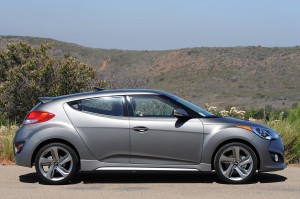




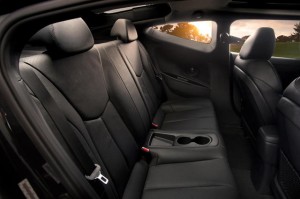
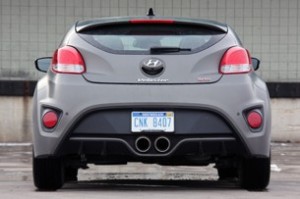
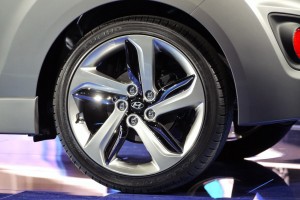
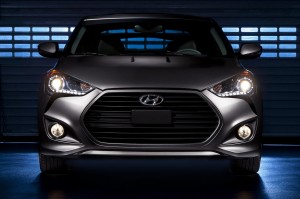

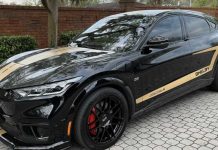





When I was a teenager in the mid 80’s Hyundai’s were only 2nd in jokes to Yugo’s.
When I look at this car I can’t believe how far they’ve come.
The lines are gorgeous. The Genesis is a great looking car too.
Me too, Nick –
I remember the Excel – Christ on a stick, that thing was a piece of shit!
And here we are, only about 25 years later…
But, yes Eric, it is one kool ride and the 274Hp engine would multiply that factor,considerably, if, the TS could be managed effectively.
The ‘Ultimate’ pkg makes the car, gives it that really kool factor with that big sky roof.
I like the diminutive or hypcorism… V-ster
OK! Which is it $20,000 or $26,000 for the Fiat Abarth? Fiat gives a price of $22,00 and $26,000 for the Cabrio. These figures skew the the comparisons.
Don’t like FWD’s, but my time in a Veloster had me wanting one for a warranted trip car, but then I have too consider the the new Mazda CX-5, and some how the CX-5 seems like a better more practical value, regardless of its more limited warranty.
Haven’t driven the Turbo Veloster, but the performance of the base model seemed just fine.
Hi Deuce,
These two- the Abarth 500 and the Veloster – have very different personalities. Joe Pesci in Goodfellas (the Abarth 500) vs. something a bit more… subtle.
I love the Abarth. But then, I love old Kaw two-stroke triples (and Joe Pesci, too). Like them, it is loud – and proud. It makes its presence felt everywhere it goes. It is a lot of fun – but, as any everyday car, I think I’d go with the Veloster. It is also fun – but you’ll probably be able to get away with more fun in it than in the Abarth, if only because every cop for a mile around won’t hear you coming (as they will if you drive an Abarth, which is one of the – no, the – loudest factory stock modern cars I have driven. It sounds great – but it sounds like half a ’69 Z-28 with chambered pipes.
There is also the real estate (and access) issue. If I had to have one of these two as my everyday car, the Hyundai wins again. My father-in-law happened to be here during the week I had the Veloster. He’s about my height and 30 pounds heavier. He could get in and out of the Veloster’s back seat. Not ideal, but doable. Impossible, in the Fiat.
But if I were single and didn’t need to worry about carrying people….
Bottom line: Both are very, very cool cars.
Hi! Eric,
Another good write up Eric, a lot of ‘so called’ automotive journalists should read your stuff for a few lessons on how to do it properly.
I wasn’t comparing the Abarth with the V-ster, just wanted to note/clarify the Abarth pricing. I have driven the Abarth and the Fiat 500, they are kool cars, but not very practical, which the V-ster certainly is. The 500 and Abarth are very much niche cars, the V-ster certainly applies to a wider demographic and is just as kool.
I love small bore bikes and cars in a different way then big HP rides. My stable of vehicles offer rides with about 16Hp to over 600Hp, but for easy fun, I gravitate to the high RPM, low Hp vehicles. Squeezing another MPH(72-73 mph) out of my Honda DOHC 125cc racer by tucking in tighter and with my face planted on the speedo, has a certain thrill for me. So the base Veloster’s low Hp output doesn’t bother me, especially since I lived through the era when 74Hp in my new 1973 Opel Manta was about average for I-4 engines in the seventies/eighties. My old venerated 1984 Nissan 720 pick-up only has 101Hp, my 1980 Chey LUV had only 84Hp, so 138Hp is a lot in comparison, and certainly adequate for my needs, as daily good MPG is more important then the occasional quick run to speed, especially if a car can get around a corner with a certain verve. The V-ster needs some help with that, but the after market is responding.
Regards …Tre
Hyundai knocks it out of the park once again. I saw one of these parked at the local Best Buy and I really liked what I saw. The wifey was very much impressed.
Agree!
Hyundai (and Kia) is displaying the verve – the love of cars as machines and industrial art – that once characterized American car companies.
Good review Eric,
It reminds me a bit of the Nissan Juke which I got to drive a while back and was a lot of fun.
Ooooh, I LIKE it!
Great write-up Eric!
… left-the-right skittering of the overwhelmed front wheels as the torque washes over them.
Ah yes! In 1989 I had one of the first Eclipse turbos. It was unheard-of performance and technology in a cheap-ish car; 200hp, available with AWD.
Dear GOD that car was fun; and exactly as you say, its turbo left no doubt about its presence, yanking the wheel this way and that and generally making the car feel like a wild cat you’d lassoed!
I used to remove the vacuum tube from the wastegate’s control valve, so the computer couldn’t pull the boost. I don’t know how much extra power it gave, but it felt like a LOT…so much that the computer would freak out at higher RPM’s and cut fuel delivery because you were maxed out on the injection cycle.
Still, it remained absolutely reliable except for the ahem factory recall for breakable cam timing belts. Yeah, and it was an interference design.
When I brought mine in, there were a dozen others with their heads pulled and valves/pistons in various stages of mangle-ment.
But a Hyundai? That’ll be reliable until the sun runs out of hydrogen.
And 22 thousand?? You’ve gotta be kidding.
Eric question for you: How’s the handling? Does it feel piggish like front-wheel-drivers tend to do, or is it sprightly? I’ll never forget a rental Mazda Protege; best-handling FWD car I’ve ever driven. Does this one betray its FWD layout or can it be fun?
methylamine,
I’ve also had my fair share of 1st gen Eclipses. I’m a huge fan of DSMs. Diamond-Star Motors was a collaboration between Chrysler, and Mitsubishi. I had a 400 wheel horsepower 1st gen Eclipse that my wife now wears on her ring finger in the form of an engagement ring! Man I miss that car. There wasn’t a car around here that could get me off the line in that eclipse. I would walk Mustangs like dogs in that little car. That car would just sling-shot me out of the hole.
I worked for Hyundai when they were pieces of shit. They certainly have come a long way. IMO, they lead the way in vehicle design. Back in the day, they were basically just stuffing Mitsu engines in a little shit box, and slapping a Hyundai badge on the back. Those days are long gone. I remember popping the hood on a Hyundai that used the old 2.4L powerplant and thinking to myself that this engine looks just like the 4G63 that powered my Eclipse. Funny how Hyundai is out in front, and Mitsu is just about a thing of the past. I will have another 1st gen DSM one day. IMO, early 90’s AWD DSMs are worth restoring and collecting.
Hi Chris,
On Mitsu: No new product until next year (2014). Everything they have in the showrooms is a carryover; some having been carried over for several years before 2012. And 2012 was a bad year for them.
I hope they pull out of the death dive they’re in, too.
Yeah, me too Eric. Mitsu used to be one hell of a car company. IMO, the only real sports cars are either RWD or AWD, and they made an awesome AWD platform to start from. Not too fast off the floor, but took to mods easy. It was relatively easy to get good power out of those old Mitsus.
I was VERY disappointed when they came out with the new Eclipse in 2000. They killed it, man. I understand that they didn’t want to cut into the Evolution sales that they brought to the states, but they could have at least gave you the option of a 4 cyl turbo. IMO, the 1995-1999 Eclipse was a sharp car, and they ruined it with the overly heavy SOHC V6 poop plant they released in 2000.
“…remove the vacuum tube…”
I mean the small pipe that carried manifold vacuum, actuated by a small solenoid valve, that in turn opened the wastegate.
No actual “vacuum tubes” on those cars!
Ha! Yeah, I caught that, and I knew what you meant. But, in the case that Mitsu was still using vacuum tubes that might explain their demise! On the old Mitsu 4G63 turbos, you would generally get about 5-8hp out of a 1 lb increase in boost. Now, that’s not true in all cases, but on a bone stock 4G63 that’s about right. Your car had about 7.5 lbs of boost from the factory, and a couple lb incease in boost would certainly be felt.
Interesting little car. Reminds me of those Yu-Gi-Oh! characters I saw once which were popular with those just hitting driving age about now.
I’m curious to find out what the “floating” door pulls inside are, exactly.
At the top of the review one of the fist things I was looking for was the rear door handle. Oh, old people are going to have a real time with that one, I think. Ha!
Also, I wonder if the seats soften up after a few hundred miles? That’s the case with another brand of vehicle. Are all car seats these days made out of the same material under the fabric?
Anyway, the review was a nice diversion from a long day.
Almost makes me want to go test drive one just for kicks.
Morning, Downshift!
On the floating door pulls – look at the picture just below the reference. They’re shaped kind of like an upside down “U,” with the upper portion not attached to anything.
Hyundai should promote whoever designed this Veloster to the top of corporate design. It looks great.
Too bad that it comes up a little short on comfort and ergonomics. That may not be a huge problem for the youthful target market for this car.
If it were a little faster and accommodating inside, the Veloster might appeal to a huge buyer base. It could be a Korean reincarnation of the original Ford Mustang.
Hi Mike,
Yup!
And, I’m pretty tall. Most people aren’t my height – 6 ft 3 – let alone taller. Anyone 6ft 1 or less should be ok. I always mention my height when I bitch about my head scruffing up against the roof because, after all, I am tall. The car companies don’t design for me – they design for the typical person.
On power: I have this feeling – not based on any insider knowledge, just a gut feeling – that they are going to offer the 2.0 engine next year. It seems like the obvious thing to do.
The car would be smoking quick. But, it would still be pretty economical to operate. That engine (the 2.0 turbo) in the 3,200 lb. Sonata manages 22 city, 34 highway. It should do at least as well in the several hundred pounds lighter Veloster.